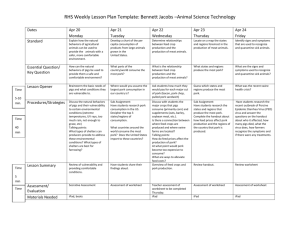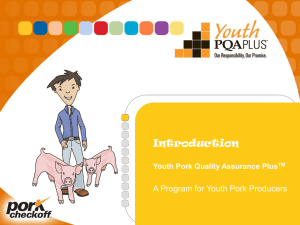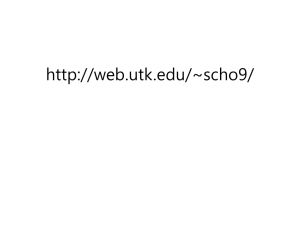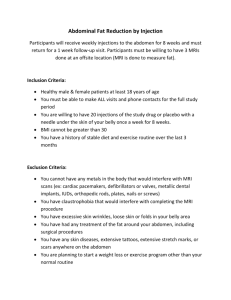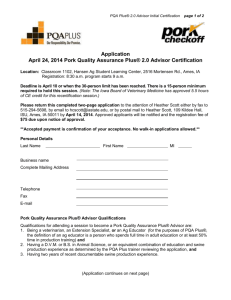Canada list of pork exempt pork cuts (2015-08-26)
advertisement
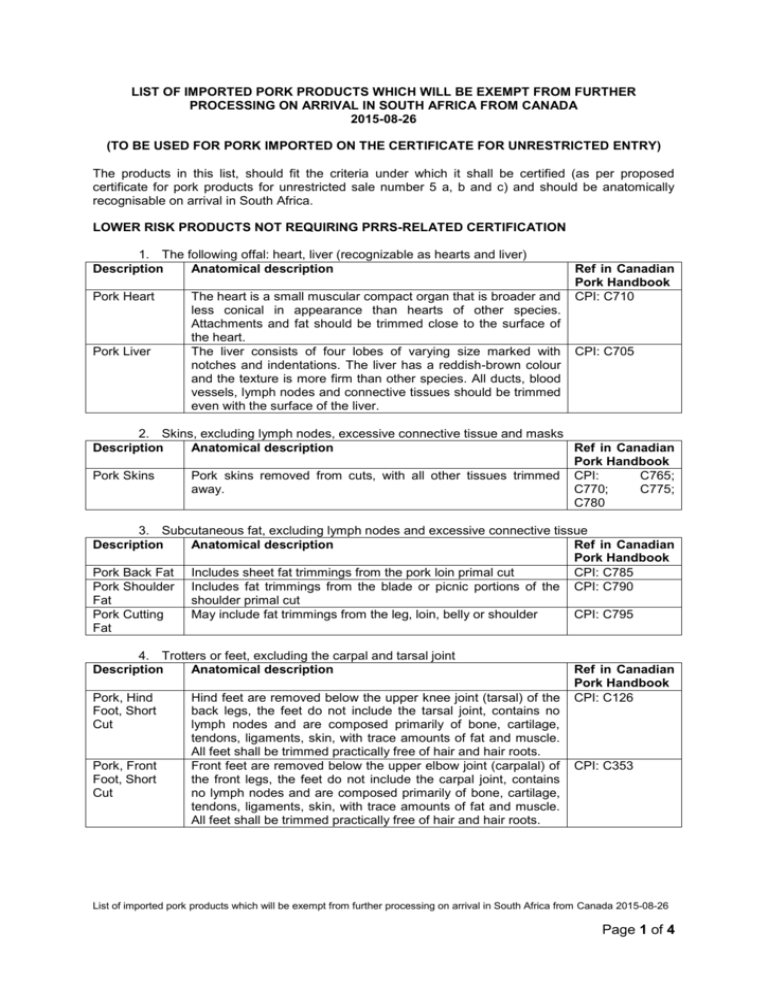
LIST OF IMPORTED PORK PRODUCTS WHICH WILL BE EXEMPT FROM FURTHER PROCESSING ON ARRIVAL IN SOUTH AFRICA FROM CANADA 2015-08-26 (TO BE USED FOR PORK IMPORTED ON THE CERTIFICATE FOR UNRESTRICTED ENTRY) The products in this list, should fit the criteria under which it shall be certified (as per proposed certificate for pork products for unrestricted sale number 5 a, b and c) and should be anatomically recognisable on arrival in South Africa. LOWER RISK PRODUCTS NOT REQUIRING PRRS-RELATED CERTIFICATION 1. The following offal: heart, liver (recognizable as hearts and liver) Description Anatomical description Pork Heart Pork Liver The heart is a small muscular compact organ that is broader and less conical in appearance than hearts of other species. Attachments and fat should be trimmed close to the surface of the heart. The liver consists of four lobes of varying size marked with notches and indentations. The liver has a reddish-brown colour and the texture is more firm than other species. All ducts, blood vessels, lymph nodes and connective tissues should be trimmed even with the surface of the liver. Ref in Canadian Pork Handbook CPI: C710 CPI: C705 2. Skins, excluding lymph nodes, excessive connective tissue and masks Description Anatomical description Ref in Canadian Pork Handbook Pork Skins Pork skins removed from cuts, with all other tissues trimmed CPI: C765; away. C770; C775; C780 3. Subcutaneous fat, excluding lymph nodes and excessive connective tissue Description Anatomical description Ref in Canadian Pork Handbook Pork Back Fat Includes sheet fat trimmings from the pork loin primal cut CPI: C785 Pork Shoulder Includes fat trimmings from the blade or picnic portions of the CPI: C790 Fat shoulder primal cut Pork Cutting May include fat trimmings from the leg, loin, belly or shoulder CPI: C795 Fat 4. Trotters or feet, excluding the carpal and tarsal joint Description Anatomical description Pork, Hind Foot, Short Cut Pork, Front Foot, Short Cut Hind feet are removed below the upper knee joint (tarsal) of the back legs, the feet do not include the tarsal joint, contains no lymph nodes and are composed primarily of bone, cartilage, tendons, ligaments, skin, with trace amounts of fat and muscle. All feet shall be trimmed practically free of hair and hair roots. Front feet are removed below the upper elbow joint (carpalal) of the front legs, the feet do not include the carpal joint, contains no lymph nodes and are composed primarily of bone, cartilage, tendons, ligaments, skin, with trace amounts of fat and muscle. All feet shall be trimmed practically free of hair and hair roots. Ref in Canadian Pork Handbook CPI: C126 CPI: C353 List of imported pork products which will be exempt from further processing on arrival in South Africa from Canada 2015-08-26 Page 1 of 4 5. Tails Description Anatomical description Tail Pig tails trimmed of lymph nodes and excessive connective tissue 6. Ears, excluding lymph nodes and excessive connective tissue Description Anatomical description Pork Ear, Square Cut The external ear of the pig is a cartilaginous skin covered structure that appears somewhat funnel shaped. A single ear with the lobe-off that is trimmed across the lobe area by a straight cut to remove all but the funnel like upper portion. Ref in Canadian Pork Handbook CPI: C130 Ref in Canadian Pork Handbook CPI: C702 PRODUCTS INDIVIDUALLY AGREED UPON 1. Bone-in or deboned meat free of lymph nodes and excessive connective tissue (must be certifiable and recognizable as such). The individual cuts and packaging will be specified on the import permit and health certificate. Bone-in or deboned meat free of lymph nodes and excessive connective tissue (must be certifiable and recognizable as such) Description Anatomical description Ref in Canadian Pork Handbook Pork Leg All bones, cartilage, skin, rectus abdominis, cutaneous trunci, fat CPI: C105 (Fresh Ham), and lean above the aitch bone, plus lymph nodes shall be Skinless, removed. The tendinous ends of shanks shall be removed so Boneless that the cross-sectional cut exposes not less than 75% lean. The loin end shall be exposed by a straight cut anterior to the quadriceps femoris. The cut shall not be less than 25mm and not more than 7.5cm from the anterior end of the femur pocket. Pork Leg The outside muscle complex consists of the outside leg muscles CPI: C106 (Fresh Ham), (biceps femoris, gluteus superficialis and semitendinosus) from Outside the leg. The gastrocnemius may remain; however the flexor Muscle digitorum superficialis shall be removed. The popliteal lymph gland and surrounding fat in excess of 6mm in-depth shall be removed. Pork Leg The inside leg muscle consists of the semimembranosus and CPI: C107 (Fresh Ham), related muscles of the inside portion of the leg, which are Inside Muscle removed from the outside and knuckle portions of the leg along the natural seam. All bones, cartilage, exposed heavy connective tissue, lean and fat overlying the aitch bone, and the gracilis membrane, shall be removed. Pork Leg The leg knuckle or sirloin tip consists of the knuckle portion of CPI: C108 (Fresh Ham), the leg (the tensor fasciae latae and quadriceps group). Knuckle Pork Loin, All skin, bones, cartilage, the tenderloin, and lean and fat CPI: C201 Boneless overlying the blade bone shall be removed. The leg-end of the loin shall be exposed by a straight cut which shows no evidence of the quadriceps femoris nor the longissimus. The sirloin may be removed immediately anterior to the hip bone pocket. In such casis, both the longissimus and gluteus medius shall be exposed on the “leg” end. On the shoulder-end, the longissimus shall be equal to , or larger than the combined areas of the splenius and semispinalis capitis. The belly shall be removed by a cut from a point ventral to, but not more than 5cm from the longissimus at List of imported pork products which will be exempt from further processing on arrival in South Africa from Canada 2015-08-26 Page 2 of 4 Pork Loin, Short-Cut Back, Boneless Pork Loin, Short-Cut Back, Boneless Pork Loin, Short-Cut Back, Main Muscle, Boneless Pork Tenderloin Pork Sirloin, boneless Pork Belly, Skinless Commercial Trim; Pork Belly, Skinless, Square Cut; Pork Side Ribs, Breast Bone Removed (Excl rib 1 and rib 2) the shoulder-end to a point on the leg-end, no more than 25mm ventral to the longissimus and/or gluteus medius. The tenderloin, all bones and cartilage shall be removed. On the blade end, the longissimus shall be approximately equal to, or larger than, the spinalis dorsi; the rhomboideus shall not be present. The sirloin is rmoved anterior to the hip bone cartilage, exposing the gluteus medius. The belly shall be removed by a cut from a point ventral to, but not more than 25mm from the longissimus at the blade end, to a point on the sirloin end ventral to, but not more than 25mm from the longissimus. All bones, cartilage, tenderloin, plus lean and fat overlying the blade bone shall be removed. The shoulder and sirloin ends shall be removed by straight cuts approximately parallel to each other. On the shoulder end, the longissimus shall be equal to, or larger than, the combined areas of the splenius and semispinalis capitis, and the sirloin shall be removed immediately anterior to the hip cartilage. The belly side shall be removed immediately ventral to the longissimus. All bones, cartilage, tenderloin, plus lean and fat overlying the blade bone shall be removed. The shoulder and sirloin ends shall be removed by straight cuts approximately parallel to each other. On the shoulder end, the longissimus shall be equal to, or larger than, the combined areas of the splenius and semispinalis capitis, and the sirloin shall be removed immediately anterior to the hip cartilage. The belly side shall be removed immediately ventral to the longissimus. The tenderloin is removed intact and consists of the psoas major, psoas minor and iliacus only. The side strip muscle (psoas minor) shall be removed. The anterior portion (tail end) shall be trimmed so that the tail is not split more than 25mm. The tenderloin should be practically free of fat. All glandular and blood tissue should also be removed. The sirloin is the portion of the full loin that remains after the center-cut loin is removed by a straight cut anterior to the hip bone and related cartilage. When a long-cut leg is produced, the sirloin piece remains intact on the leg with the light butt portion. The belly is prepared from the side after removal of the leg, shoulder, loin, fat back and spareribs. All bones and cartilage shall be removed. Practically all leaf fat shall be removed. The fat back shall be removed by a straight cut not more than 3.8cm from the outermost dorsal curvature of scribe line. The anterior (shoulder) and posterior (leg) ends of the belly shall be reasonably straight and parallel. No side of the belly shall be more than 5cm longer than its opposing side. The width of the rectus abdominis shall be at least 25% of the width of the belly on the leg end. The fat on the ventral side of the belly, and adjacent to the flank, shall be trimmed to within 19mm from the lean. The area ventral to the scribe line shall be free of scores and “snowballs” (exposed areas of fat), which measure 19.4 square cm or more. The belly shall be free of enlarged, soft, porous, dark or seedy mammary tissue. The scribe line shall be not more than 6mm in depth at any point. Side ribs should contain at least 11 ribs and associated costal cartilages. The membranous portion of the diaphragm must be removed close to the lean. Any portion of the diaphragm not firmly attached should be removed close to the inside surface of the ribs. The lean shall not extend more than 5cm past the curvature of the last rib and costal cartilage. Heart fat on the CPI: C205 CPI: C209 CPI: C211 CPI: C227; C228 CPI: C235 CPI: C400; C401; CPI: C501 List of imported pork products which will be exempt from further processing on arrival in South Africa from Canada 2015-08-26 Page 3 of 4 Pork Side Ribs, Centre Cut (Excl rib 1 and rib 2) Pork Loin, Back Ribs (Excl rib 1 and rib 2) inside surface of the ribs shall not exceed 6mm average depth. Leaf fat over the diaphragm and transverse abdominis shall be trimmed practically free. As for C501 except the sternum and the ventral portion of the costal cartilage shall be removed along with the flank portion. The breast shall be removed at a point that is dorsal to the curvature of the costal cartilage. The back ribs should consist of at least 8 ribs and related intercostals meat from the loin. The back rib sections shall be intact, and the bodies of the thoracic vertebrae shall be removed. CPI: C502 CPI: C505 2. Consumer ready cuts (as agreed upon). The individual cuts and packaging will be specified on the import permit and health certificate List of imported pork products which will be exempt from further processing on arrival in South Africa from Canada 2015-08-26 Page 4 of 4
